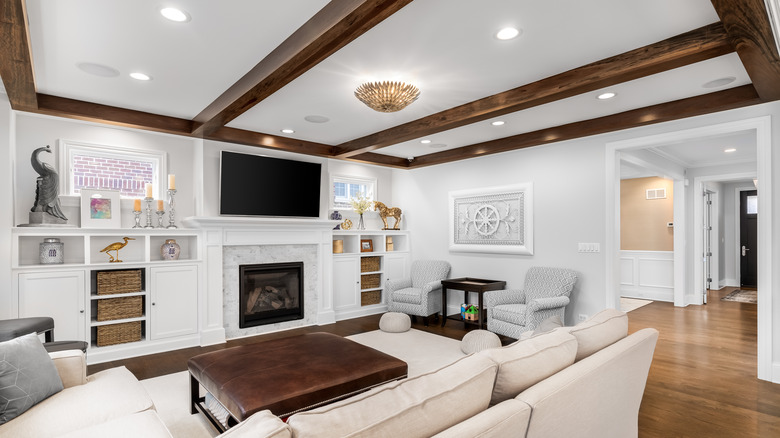Why You Never Want To Forget The Ceiling When Designing A Room
We often refer to rooms with "these four walls" but of course, there is also a floor and a ceiling in every room. Floors are usually an important consideration when designing a room: should you go with hardwood, tile, or marble? Should you have rugs or carpeting? And walls are considered the backdrop for all the other furnishings in a room. But the ceiling often doesn't receive as much consideration from a design perspective. But for some rooms, especially bedrooms, design experts agree the ceiling is every bit as important as the walls. This is because the room where we sleep should feel comfortable and soothing.
Although some old houses may have decorative elements on the ceiling (beams, molding, plaster medallions, etc.), the majority of houses have fairly plain ceilings that only need painting and light fixtures. Including the ceiling when you're planning a room's décor will ensure that all the design elements work together. So if the ceiling is an important element in designing a room, what are the most crucial choices to consider? Think about how the ceiling functions in a room. In the bedroom, for example, you may spend some time looking up at the ceiling as you lie in bed. In the dining room, the ceiling adds to the atmosphere at mealtime or during a social gathering when people are sitting together. Identifying the ceiling's function helps you determine how you want it to look.
How to choose the right color for the ceiling
It's important to choose a paint color for the ceiling that harmonizes with the rest of the room's color choices. Picking the right color for the ceiling means solidifying the room's entire look. Choosing a contrasting or eye-catching color for the ceiling, according to HGTV, gives the illusion of lowering the ceiling, adding a cozy feeling of intimacy. This feeling might be desirable in rooms where you want to relax, like a study, or in the bedroom. Just be sure to choose colors that are generally calm-inducing, like pastels, neutrals, and muted shades of blue, gray, or green. Warm muted shades like rose and mauve are also good choices for the bedroom.
You can play up the room's color scheme by keeping the ceiling in the same color family. Designer Shelly Riehl David recommends painting your ceiling in the same color as your walls but in a lighter hue. He told HGTV: "Ask the paint store to knock down the color 20 percent for the ceiling." Lighter versions of the paint you choose are usually available on paint chip samples, too. If you choose a darker hue for your ceiling, you can help accentuate features such as metallic light fixtures or decorative medallions. Try navy blue with brass fixtures, deep forest green with a white plaster medallion, or maybe deep rose to contrast with cream-colored molding trim.
Other ceiling ideas
What if you have an unusual ceiling surface? Some ceilings have textured plaster, beams, elaborate moldings, or large plaster ornaments. These decorations can be beautiful, and can even become focal points for the room, assuming you like them. Some homeowners add vintage-looking features such as crown molding or ceiling medallions to make a newer house look older or take care to restore the ones that come with an older home.
Wooden ceiling beams can be gorgeous, whether they're natural wood or painted. Some designers, including HGTV's Jonathan Scott, even recommend adding unpainted beams to your ceiling for a rustic Scandinavian or farmhouse look. If your beams have been painted, a contrasting color scheme can be a real attention-getter. Use a glossier finish paint on the beams themselves, to catch the light and balance the matte finish of the ceiling.
But if you're not a fan, say, of the swirly plaster designs in your ceiling (this kind of ceiling finish was popular in the 1970s), there are also ways to downplay them using paint. Be sure to use a flat or eggshell finish paint for any plasterwork you don't want to call attention to. Keeping the color as close as possible to the wall colors will also let the ceiling blend into the rest of the room.

